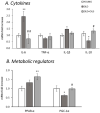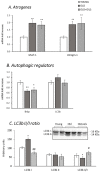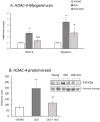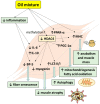Beneficial Effects of a Mixture of Algae and Extra Virgin Olive Oils on the Age-Induced Alterations of Rodent Skeletal Muscle: Role of HDAC-4
- PMID: 33375628
- PMCID: PMC7824654
- DOI: 10.3390/nu13010044
Beneficial Effects of a Mixture of Algae and Extra Virgin Olive Oils on the Age-Induced Alterations of Rodent Skeletal Muscle: Role of HDAC-4
Abstract
Aging is associated with a progressive decline in skeletal muscle mass, strength and function (sarcopenia). We have investigated whether a mixture of algae oil (25%) and extra virgin olive oil (75%) could exert beneficial effects on sarcopenia. Young (3 months) and old (24 months) male Wistar rats were treated with vehicle or with the oil mixture (OM) (2.5 mL/kg) for 21 days. Aging decreased gastrocnemius weight, total protein, and myosin heavy chain mRNA. Treatment with the OM prevented these effects. Concomitantly, OM administration decreased the inflammatory state in muscle; it prevented the increase of pro-inflammatory interleukin-6 (IL-6) and the decrease in anti-inflammatory interleukin-10 (IL-10) in aged rats. The OM was not able to prevent aging-induced alterations in either the insulin-like growth factor I/protein kinase B (IGF-I/Akt) pathway or in the increased expression of atrogenes in the gastrocnemius. However, the OM prevented decreased autophagy activity (ratio protein 1A/1B-light chain 3 (LC3b) II/I) induced by aging and increased expression of factors related with muscle senescence such as histone deacetylase 4 (HDAC-4), myogenin, and IGF-I binding protein 5 (IGFBP-5). These data suggest that the beneficial effects of the OM on muscle can be secondary to its anti-inflammatory effect and to the normalization of HDAC-4 and myogenin levels, making this treatment an alternative therapeutic tool for sarcopenia.
Keywords: HDAC-4; aging; atrogenes; autophagy; extra virgin olive oil; omega 3 fatty acids; sarcopenia.
Conflict of interest statement
As this work was carried out in collaboration with the pharmaceutical company Pharmactive Biotech Products S.L., authors from this company may have conflicts of interest. However, the in vivo study was performed by academic researchers from the Universidad Autónoma de Madrid. The sponsors had no role in the design, execution, interpretation, or writing of the study.
Figures






References
-
- Carnio S., LoVerso F., Baraibar M.A., Longa E., Khan M.M., Maffei M., Reischl M., Canepari M., Loefler S., Kern H., et al. Autophagy impairment in muscle induces neuromuscular junction degeneration and precocious aging. Cell Rep. 2014;8:1509–1521. doi: 10.1016/j.celrep.2014.07.061. - DOI - PMC - PubMed
MeSH terms
Substances
Grants and funding
LinkOut - more resources
Full Text Sources
Medical

